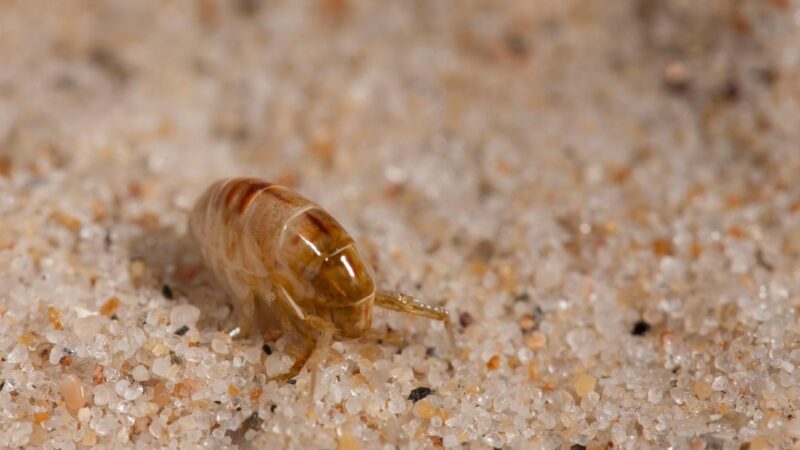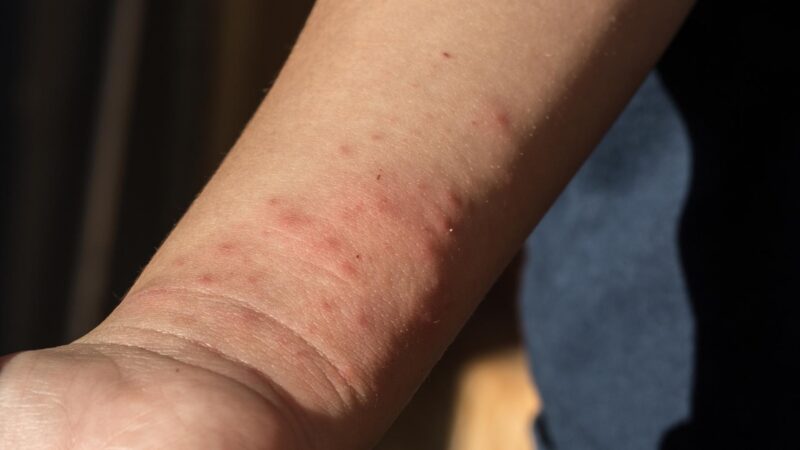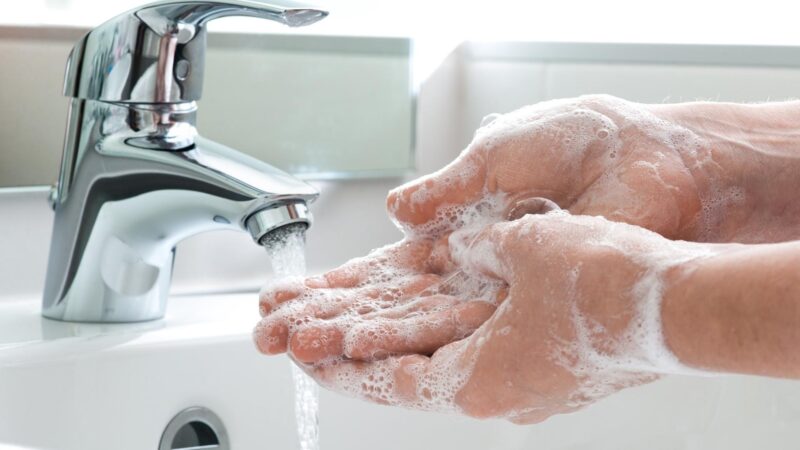Sand fleas are incredibly tiny creatures at just a millimeter long. However, they can transmit a nasty skin disease that can cause itching, pain, and lesions on an infected person. This is why it’s important to be prepared for the treatment and prevention of sand flea bites.
To prevent sand flea bites, use an insect repellent, and wear long clothing as much as possible. Avoid using heavily-scented products, and protect your pets through regular sanitation. You can apply immediate care by cleaning the bite area with soap and water, then applying a cold compress or ice pack to reduce itching and swelling.
To know more about sand fleas, what they look like, how long their bites can last, how to treat them with immediate care or through a healthcare provider, and other essential information, read further this article!
Table of Contents
What Is a Sand Flea?

Also known as the jigger or chigoe flea, the sand flea (Tunga penetrans) is a parasitic insect that lives in tropical and subtropical environments. Adult female fleas of this species are known to cause a skin infection called tungiasis.
True sand fleas should not be mistaken for mole crabs and sand flies, which are two completely different animals but both are also colloquially referred to as sand fleas. Mole crabs are a group of crustaceans belonging to the genus Emerita. They don’t bite humans and are generally harmless.
Sand flies, on the other hand, are also parasitic insects that feed on the blood of their hosts and can transmit disease organisms. However, their appearance resembles that of a moth, and they belong to the order Diptera whereas fleas belong to the order Siphonaptera.
What Do Sand Fleas Look Like?
Sand fleas are reddish brown in color and have flattened heads that lack ctenidia combs, or rows of flat and pointy spines found on the head and thorax, which are present in other species of fleas such as the dog flea (Ctenocephalides canis) and the cat flea (Ctenocephalides felis).
Compared to most fleas, females have well-developed lacinia or teeth structures used for puncturing through hosts, and an epipharynx, a tube-like canal where blood is sucked through. These biological structures are beneficial for their invasive way of living.
How Big Is a Sand Flea?
Sand fleas are the tiniest known fleas at only 1 millimeter in length. However, if they are embedded onto human skin and become engorged by the blood of their hosts, they can reach up to 1 centimeter.
What Do Sand Flea Eggs Look Like?
Eggs of sand fleas are tiny (about half a millimeter in size), oval-shaped, smooth-surfaced, and have a dirty white color. Although they are miniscule, they are still visible to the naked eye. An adult female flea can lay up to a total of 200 eggs during its entire three-week lifespan.
Why Do Some Beaches Have Sand Fleas?

Since they live in tropical and subtropical climates, sand fleas have taken a liking to beaches, particularly those found in the Caribbean, South America, and Africa. They burrow onto the sand, which earned them one of their many nicknames: the burrowing flea.
What Does a Sand Flea Bite Look Like?

Sand flea bites look like tiny bumps that are reddish or pinkish in color and are slightly raised from the bitten area. They are initially painless but will become more uncomfortable for an infected person as the adult female flea continues to feed on their blood.
Additionally, lesions that are caused by tungiasis, which is transmitted through sand flea bites, are disc-shaped papules that are whitish and with a dark circle in the middle that further darkens as time passes by. The central black circle is a female flea’s posterior end which it sheds after it dies.
The lesions are usually found on the feet and ankles as they are the common entryways of sand fleas, specifically on the toes, toenails, and soles. They attach themselves to their hosts using their well-developed mouthparts and claw their way deeper into the epidermis. However, they can also be found on the hands, legs, elbows, knees, and buttocks.
How Long Do Sand Flea Bites Last?
Anywhere between 2 to 6 weeks, as sand fleas typically live for that long. After female fleas die, their eggs are expelled and all fall to their external environment. Secondary infections, which are caused by bacteria entering the lesions, can occur. In this case, even as the bite disappears, symptoms like itching and pain will continue.
How Long Does It Take for Sand Flea Bites to Go Away?
Around 2 to 6 weeks depending on the severity of the sand flea infestation and the effectiveness of the treatment acquired by the patient.
How Long Do Sand Flea Bites Itch?
Itching and pain usually start when the female sand fleas start to feed on the blood of their hosts and grow in size inside the epidermis. As they become fully developed, they enter into an engorged state and have grown up to 1 centimeter in diameter. In this case, inflammation will occur as well as lesions and ulcerations.
In worst-case scenarios, a patient can get multiple lesions on their feet, which can lead to walking difficulties.
What to Do for Sand Flea Bites?

- Clean the bitten area thoroughly with soap and water.
- Apply a cold compress or ice pack to reduce swelling and itching. You can also use aloe vera for its soothing effects.
- If itching persists, use an antihistamine. Be it in a tablet, liquid, or topical form (cream or ointment). Products that contain hydrocortisone are recommended.
- If you’re experiencing pain, drink acetaminophen as directed by its label.
- Call your physician or healthcare provider immediately if any of the above treatments are not working to decrease your symptoms.
What Does Sand Flea Rash Look Like?
Flea rashes usually look like tiny, red bumps that are in clusters of three or four or line up in a straight line. The rashes can also swell and blister as the sand flea grows in size and creates a lesion on the bite area.
How to Treat Sand Flea Bites?
When immediate care does not reduce symptoms of the sand flea bites, the standard treatment procedure is usually a surgical extraction of the sand fleas performed under sterile conditions in an appropriately-equipped health facility or at least by a trained health worker or professional using sterile tools. The wound is subsequently dressed aptly, and the patient is issued a tetanus vaccination with a booster if indicated.
In endemic areas, extraction is done by the patients themselves or with the aid of a health caregiver. Instruments such as hairpins, scissors, sticks, and sewing needles are used. It should be important to note that extraction should be performed by an experienced health worker, or else you’ll risk having a superinfection as well as possibly transmitting other diseases.
How to Get Rid of Sand Flea Bites?
Make sure to clean and disinfect the bite area to avoid acquiring infections. Afterward, apply an ice pack or cold compress to reduce itching, swelling, and pain. Antihistamines can also be used to further reduce symptoms.
Sand flea bites can cause scarring if a patient scratches or picks at the bites and lesions. Generally, these will fade off onto their own with time and enough patience. However, if you want to hasten the process, consult your dermatologist for the appropriate treatment, which includes the use of lightening creams, laser treatment, or chemical peels.
How to Prevent Sand Flea Bites?
- Communicate with your healthcare provider regarding the use of a safe insect repellent that you can apply either topically or place in your living areas.
- As much as possible, wear long-sleeved shirts, long pants, and slippers when going outdoors to reduce the risk of coming into contact with sand fleas.
- Avoid using heavily-scented lotions, soaps, and other cosmetic products, as this can potentially attract fleas.
- Protect your pets too, as they are also vulnerable to sand flea infestations. Make sure their living environment is thoroughly and regularly sanitated.
Sand fleas are parasitic insects that are found in tropical and subtropical environments. Adult females are the only ones that could bite and transmit tungiasis to humans. Once bitten, the flea will live on its host’s epidermis and thrive off of its blood until they get engorged with it. An infected person will experience itching, pain, swelling, and lesions.
List of Sources
Tungiasis. (2017). Centers for Disease Control and Prevention.
Houseman, R. M. (2014). Fleas. University of Missouri.
TOPIC 43. Siphonaptera (fleas). (2005). Kansas State University.
Perez, E., Foley, M., Goode, P. Flea, Mite, or Chigger Bites. University of Rochester Medical Center.
Richman, D. L., & Koehler, P. G. (2007). Fleas: What They Are, What To Do. University of Florida.
